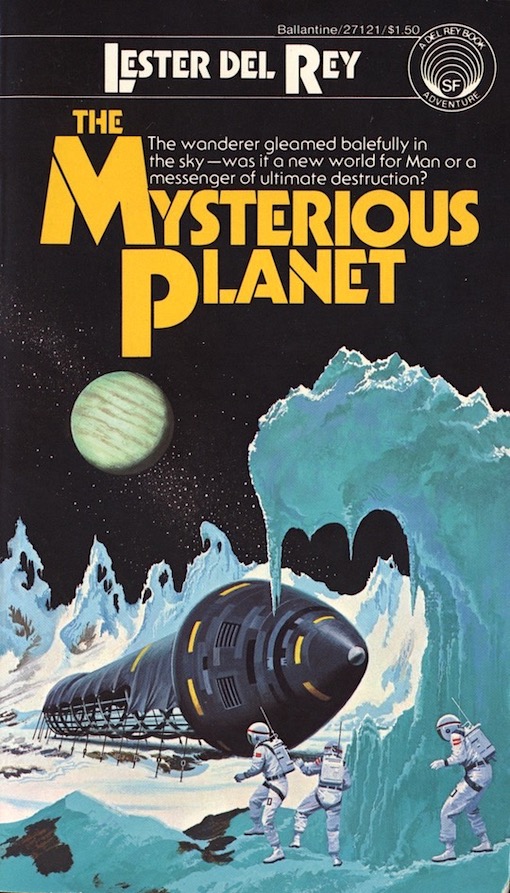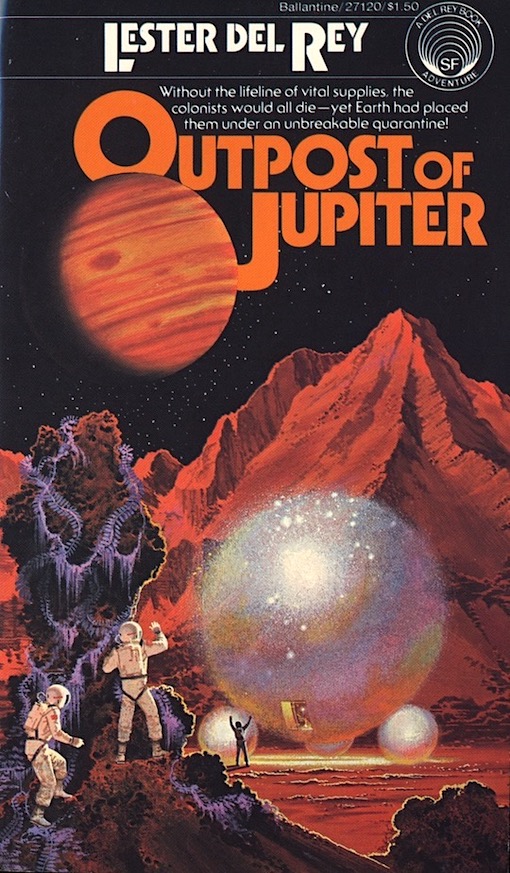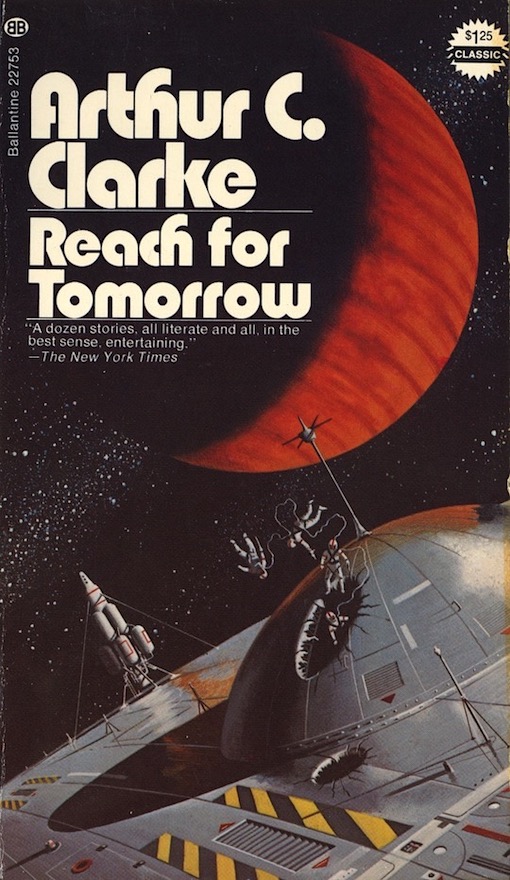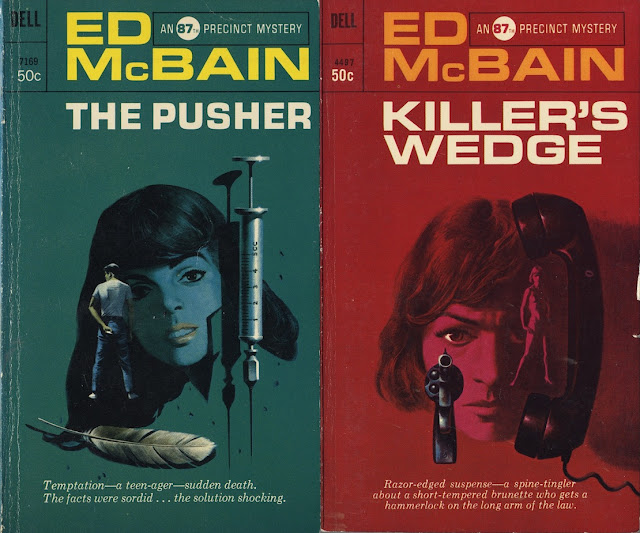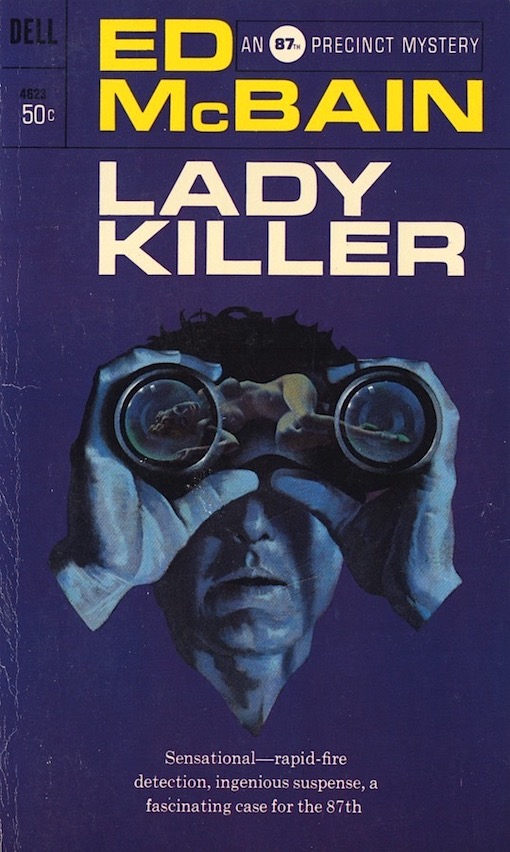I LOVE the science fiction art of Dean Ellis. His tight, well-crafted illustrations were perfect at capturing the pragmatic side of the genre, while still promoting spaciousness, detail and a strong sense of wonder. His style of posterized imagery was also perfect for retrofitting on a 4 x 7 inch paperback cover.
Dean Ellis (1920-2009) was born in Detroit, Michigan, and served as an infantryman in the Pacific theater during WWII. He received his formal art training at the Cleveland Institute of Art, with postgraduate work at the Boston Museum School of Fine Art. In 1950, Life magazine included Ellis in a list of the 19 most promising young American artists. I would venture to say that Ellis has exceeded every expectation they had of him. While freelancing for nearly all of the major publishers in the science-fiction field, Ellis produced hundreds of memorable book and magazine covers, practically dominating the genre during its most influential decade, the Seventies. He also painted portraits and produced extensive advertising illustrations for magazines such as Popular Science, Popular Mechanics, The Saturday Evening Post and Life.
In the late 1960's, under the guidance of legendary Bantam Books art director Len Leone, Ellis produced several outstanding book covers for a series of important Ray Bradbury paperbacks. The most famous of those paintings, "The Illustrated Man" (Bantam, 1969), was recently sold at auction by the Bradbury Estate for approximately $45,000. On average though, Ellis's works usually sell for between $400 to $4,000, depending upon size and subject matter.
During the 1980's, while commissioned by the Unicover Corporation, a major client, Ellis completed an astonishing number of oil on board portraits of prominent Americans, for a special series titled "Shapers of America." He also designed dozens of cool looking stamps for the U.S. Postal Service and several foreign governments. Ellis has shown his work at the Whitney Museum in New York, the Metropolitan Museum of Modern Art, the National Academy, and at most of the major museums throughout the country during the 1960's, 70's and 80's. His paintings are proudly represented in more than 27 private collections around the world.
Ellis generally worked with gouache or acrylic on paper and masonite for the majority of his book covers, but he did use other forms of medium, including oil and tempera. As alluded to in the post title, Ellis was a master of his medium and one of the finest talents to have ever embraced the science-fiction field.
In 1974, Walt Disney Studios filmed Ian Cameron's exceptional adventure novel The Lost Ones (Avon, 1974) as The Island at the Top of the World. The story follows the efforts of a search & rescue team in the Arctic that is trying to locate a downed pilot, in an area so remote and mysterious that even the native Inuit fear its location. I found the movie really fun to watch, reveling in its picturesque airship, whales, Vikings and volcanoes, but the novel is actually the better of the two formats; it allows for an incredible, yet grounded journey into the fantastic. It's adventure fiction at its very best. Ellis's cover art seems to support that notion as well, especially if you're willing to suspend your disbelief that a whale can be frozen in a mountain of glacial ice.
'A captain seeks his son, only to be caught in the mysteries of a bizarre civilization---the remnants of ancient Vikings and the keepers of a strange graveyard worth a fortune. Battling the strange people as well as defiant forces of nature, the captain finds a puzzle even stranger than the disappearance of his son.'
Ian Cameron is a pseudonym, one of three that British born writer Donald Gordon Payne (1924- 2018) employed while writing his books (he also wrote non-fiction). His other pen-names are James Vance Marshal (The Children aka Walkabout, and Still Waters), and Donald Gordon (Star-Raker, Flight of the Bat, The Golden Oyster, and Riders of the Storm). You can't go wrong reading any of Cameron's books--he was an excellent writer in every regard.
 |
| CLICK ON IMAGE TO ENLARGE |
Ellis's majestic wraparound illustration on The Mountains at the Bottom of the World (Avon, 1974) provided plenty of visual inducement for prospective book buyers--it certainly had me clutching it. Ian Cameron's exciting and extremely plausible Chilean adventure novel was basically an homage to Sir Arthur Conan Doyle's The Lost World, with a dash of Hammond Innes thrown in for added flavor.
"It turns out to be quite a story as Cameron spins another of his hair-raising epics that has the reader squirming while the handful of assorted humans struggle to escape from the fate the ape men have planned for them." --- The Sunday Oklahoman.
The White Ship was yet another of Cameron's terrific ice adventures that benefited from Ellis's unique style and imagination. Avon published this novel in 1977, but as awesome as it is (and is it ever), it has never been reprinted.
'It was a treacherous undertaking-- an expedition to a glittering ice-capped Antarctic Island, ravaged year-round bout the primordial fury of the elements, seething with volcanoes ready to unleash their earth-shaping fire, and haunted by subterranean caves that echo with supernatural cries. A place of savage beauty-- and unpredictable terror! They came in search of the legendary "golden" seals, but cut off from the outside world by the impenetrable ice, they encountered a chilling vision of a ghost-ship on an ill-fated voyage and were forced to relive the past in an ice-bound hell!'
It's a truly fantastic looking island that Ellis created for Roger Zelazny's SF novel Isle of the Dead (Ace, 1985). That said, I still wouldn't want to try and cross this churning ocean on a raft because even if you reached the island you'd still have to somehow disembark and tie-off without getting pummeled against the rocks---or is that a fortuitous strip of sand I see at the base of the stairs?
'In is centuries in the future, and Francis Sandow is the only man alive who was born as long ago as the 20th Century. His body is kept young and in perfect health by advanced scientific methods; he has amassed such a fortune that he can own entire planets; and he has become a god. No, not a god of Earth, but one of the pantheon of the alien Pei'ans: he is Shimbo of Darktree, Shrugger of Thunders. Yet he doesn't believe that his personality has merged with the ancient consciousness of Shimbo, that he really can call down the skies upon his enemies. The time comes, however, when Francis Sandow must use these powers against the most dangerous antagonist in the universe: another Pei'an god, Shimbo's own enemy, Belion. And Belion has no doubt whatever of his own powers... '
 |
| CLICK ON IMAGE TO ENLARGE |
In 1974 Ballantine published Alan Dean Foster's science fiction novel Icerigger as a mass-market paperback original (PBO). I basically bought a copy because of the great wraparound cover art by Ellis, but try as I could I was never able to read past the opening chapters. Ironically, Foster's epic eight book fantasy series Spellsinger is one of the most immensely readable series I have ever encountered. But I suppose that's the way it is with any author; sometimes their books fly after takeoff--and sometimes they crash after takeoff.
When Lester Del Rey became editor at Random House in 1977 (post Ian Ballantine's tenure) he quickly established a science-fiction imprint and named it after himself (or his wife, Judy-Lynn, who he hired as co-editor). This allowed him the freedom, or power, to republish several of his own novels, starting with The Mysterious Planet, which was initially published under a juvenile banner by the John C. Winston Book Company in 1953. Ellis quickly became the artist of choice for most of these republications.
'Planet X: Discovered out beyond Pluto, the mysterious planet was at firs an astronomical curiosity. Then calculations indicated that its strange orbit would bring it closer to the sun... at twice the speed any planet could move. Wing Nine of the Solar Federation Navy, on its way to investigate the intruding world, encountered a pirate craft armed with unfamiliar weapons, capable of incredible speed, and fleeing toward Planet X. Then more of those strange ships appeared, and the Navy geared up for the first space war. But Cadet Bob Griffith stubbornly clung to his belief that Earthman and alien could meet peacefully. So, defying orders, he drafted an unstable and spoiled playboy and his space yacht for a last-chance try at stopping Armageddon. For if the might of the Federation met the advanced weaponry of the aliens from Planet X, the inevitable clash would surely destroy all life in the solar system!'
Moon of Mutiny was initially published in 1961 as a juvenile title by Holt Rinehart & Winston. It was then republished by Del Rey in 1978, and smartly marketed by Lester to be an adult title using Ellis as the cover illustrator.
'Pure luck had gotten Fred Halpern assigned to fly an emergency mission to the Moon. But, once there, he lived under a cloud of distrust and was treated with suspicion by the other members of the exploration team. On the harsh and deadly lunar surface, iron discipline was all that kept humans alive--and Fred had been washed out of the Space Academy for disobeying a direct order. It wasn't his fault that vital equipment failed and bad luck plagued the expedition--but he was tagged as a jinx and warned to do what he was told and to stay out of trouble. So when a spaceship crashed nearby, Fred found himself in a desperate situation. He was sure he knew the ship's location and so could rescue the survivors. But he was ordered not to try. This was his final test: Should he obey orders and let two men die or should he back his own hunch with the one crime unforgivable on the Moon... mutiny!'
Even after the John C. Winston Company merged with Holt Rinehart in 1961 they continued to support a line-up of juvenile science-fiction, which included the 1963 publication of Lester Del Rey's Outpost of Jupiter. In 1978 it was republished by Del Rey using one of Ellis's most wondrous illustrations.
'When his father's sudden illness stranded the Wilsons in the tiny human colony on Jupiter's moon, Bob gave up his plans for college and joined the colonists in their struggle against the brutal environment of Ganymede. The challenges, the comradeship he found, and the awe-inspiring spectacle of Jupiter filling the sky--all exhilarated Bob far beyond his expectations. So did his investigation of the major mystery behind the strange globe that was hidden out in the hills and that seemed to be trying to communicate with the colony. Before he could find the answer, a plague struck and crippled the colony. Then enraged and fearful colonists accused Bob of being the carrier!'
Here is Ellis's vision of a manned colony on the Moon, derived from Arthur C. Clarke's 1955 fix-up novel Earthlight. Ballantine published this paperback edition in 1974.
'Sadler knew that the discovery of heavy metals on the Moon could lead to a devastating war between Earth and the younger colonies of Mars and Venus. And someone in the quiet, respectable group of scientists on the Moon--someone Sadler had to find--was passing information to the unseen warships in outer space... Was it Jamieson, the young astronomer devoted to the peaceful pursuit of pure science... or Jenkins, whose contacts in Supply gave him easy access to couriers from the rival planets... or even Director Maclaurin, whose knowledge of Earth's plans made him the most dangerous if he chose to tell... If the war came, the Moon would be the target. But Sadler's job was to prevent that war if he could... while the uneasy days, hours, seconds ticked away.'
Arthur C. Clarke's short story collection Reach For Tomorrow (Ballantine, 1963) went through five printings with abstract painter Richard Powers initial cover art before Ballantine replaced it in 1972 with a decidedly more realistic approach by Ellis.
Challenge The Hellmaker (1976) by Walt & Leigh Richmond, was the sixth of eleven paperback originals published by Ace, as part of its Science Fiction Special Series 2. Ellis provided the cover art for this item and several other titles in the series.
'Earth has become dominated by the repressive U.N. Security Corps. The last barrier to its total dictatorship is a small group of international scientists isolated on a space station miles above the Earth... and the Hellmaker.'
The Mind Parasites (Bantam, 1968) was occult scholar Colin Wilson's first outright science-fiction novel, and it featured editor and fellow author August Derleth as a minor character, which sorta suggested to me that the novel is Cthulhu-like in nature--but that's neither a recommendation for or against it. The cover art by Ellis is absolutely marvelous though.
'POWER that took one man to track its direction from the signs left by history. POWER that has enslaved mankind from the beginning. POWER that holds humanity from its birthright of total consciousness. POWER that keeps each of us penned in a private prison of fear. POWER that demands our extinction rather that surrender.'
Ellis's "discovering alien artifacts" illustration on the cover of As On A Darkling Plain is reminiscent of, or possibly inspired by, the black monolith in Arthur C. Clarke's novel 2001: A Space Odyssey. Dell published Ben Bova's novel in 1974. The odd title was lifted from the fifth stanza of a Victorian Age poem (y.1867) by English poet Matthew Arnold:
Ah, love, let us be trueTo one another! for the world, which seemsTo like before us like a land of dreams,So various, so beautiful, so new,Hath really neither joy, nor love, nor light,Nor certitude, nor peace, nor help for pain;And we are here as on a darkling plain
Swept with confused alarms of struggle and flight,Where ignorant armies clash by night.
A giant alien saucer-ship, as imagined by Ellis for the 22nd printing of Arthur C. Clarke's fix-up novel Childhood's End (Ballantine, 1972). In Clarke's story, human culture, creativity and identity are being smothered by the Overlords, a ruling alien invader race, under the guise of peaceful utopian living--a premise that perhaps some people right now might say is not too far off from their actual reality.
'CHILDHOOD'S END is a novel of the next step in the evolution of Man. It is compounded of intellectual daring and vaulting imagination---a book in the great tradition of the novel of ideas. it tells of a world made perfect and a race transformed---and of the unexpected tragedy of perfection.'
 |
| CLICK ON IMAGE TO ENLARGE |
Ellis placed his stark statue of "representational man" against the backdrop of a domed city on Eric Maine's science fiction novel Alph (Ballantine, 1972, also issued as World Without Men). Eric Maine was the pen-name of English writer and electrical engineer David McIlwain (1921-1981), who also wrote thrillers and detective fiction under the pseudonyms Richard Rayner and Robert Wade. Maine had some of his work adapted into radio and television plays and even a few feature films: Spaceways, The Electronic Monster, The Atomic Man, and The Mind of Mr. Soames.
A re-purposing, and apparent vandalizing, of Ellis's manful statue on Ace's second paperback printing of Philip K. Dick's novel The Man Who Japed (1973).
'War and famine had been abolished through Morec, Moral Reclamation; peace and prosperity were the rule--they were, in fact, compulsory. Block committees, robot informers and youthful goon squads made sure everyone "enjoyed" Morec. Allen Purcell, the new director of Entertainment and Propaganda, had always been happy in his world. At least he thought he was until he joined the world-wide hunt for the mad japer who was playing insulting pranks on the government. For in the search for the heretical prankster, Purcell found evidence pointing to himself as the culprit. If it was true--how did he do it? and how could he face the full force of an outraged society if he was discovered?'
Ellis's cover art for The Man Who Awoke (Ballantine, 1975) is an obvious homage to H. G. Well's classic alien invasion novel The War of the Worlds, but the novel is actually more akin to Well's other classic novel, The Time Machine.
'Norman Winters slept soundly. Five thousand years at a time. But what worlds did he wake to? 5,000 A.D.: Humanity staggers to save itself amid the world's littered, stagnant wreckage after the great Age of Waste. 10,000 A.D.: The world governed by The Brain--the inexorable machine that knows all, sees all and feels nothing. 15,000 A.D.: A life so unbearable to face that humans program their choice of dreams and sleep their lives away! 20,000 A.D.: After the Age of Freedom came the Age of License. And after that, the terrifying Age of Anarchy. 25,000 A.D.: At last, humanity discovers the secret sought through the centuries--but what price glory?'
The Canadian born Laurence Manning (1899- 1972) all but terminated his science-fiction writing career in 1935 in order to further his Kelsey mail-order nursery business. Apparently, selling plants during the Great Depression was deemed more lucrative than selling fiction stories, unless of course you happened to be Lester Dent, the greatest pulp writer of them all, whose earnings per year exceeded six figures, an enormous sum in that era.
Another masterful saucer-ship by Ellis, this time on Ace's 1972 3rd printing of Andre Norton's novel Judgement on Janus. Much to my dismay, Ellis was not commissioned to do the sequel, Victory on Janus--instead it fell on another artist.
'Naill Renfro is working as a slave laborer for the farm colonizers of Janus when he discovers a forbidden treasury which lures him into the planet's towering forests. There Naill is mysteriously transformed into the tree dweller Ayyar of Iftcan and fights a strange fight to regenerate the ancient race...'
Andre (Alice) Norton (1912- 2005) barely needs an introduction to most science fiction fans. They were either weaned on her, or Heinlein, or both, but she did achieve some major milestones during her incredible career that I want to mention. In addition to publishing more than 300 books, Norton was the first woman to be inducted into the Science Fiction and Fantasy Hall of Fame, and the first woman to be proclaimed Grand Master of Fantasy (Gandalf Award), and Grand Master of Science Fiction (Nebula Award). And, in 2005, the Science Fiction & Fantasy Writer's of America (SFWA) honored her yet again by creating a special Andre Norton Award, to be given out each year to an outstanding work of young adult fantasy or science-fiction.
The first U.S. paperback edition of Brian Aldiss's Starship (Signet, 1960), flaunted an attractive Paul Lehr cover that no doubt pushed sales favorably, but it was the above cover illustration by Dean Ellis on Avon's 1969 reprint that finally inspired me to read the book. And what a great decision it was because Starship, originally published as Non-Stop, is an excellent example of the kind of imaginative storytelling that represents the best of what science fiction should be, but all too often isn't.
'In the savage world of the Greene tribe, losing a woman was unforgivable, and Roy had lost his while hunting in the jungle called "the ponics." Disgraced, isolated, he joined the disreputable priest Marraper on a forbidden expedition through Deadways to find the legendary land of Forwards. They were to meet mutants, and giants, regimented rats and telepathic rabbits, and the fabled Outsiders. Finally they would confront a secret kept hidden for 23 generations--a secret whose discovery would reveal their origins and destiny even as it destroyed their world!'
I've tried to read Hiero's Journey (Bantam, 1974) twice now without success. That first chapter just never seems to hold my attention, but Ellis's monsterific cover art will undoubtedly have me trying thrice, which I hope is the charm.
'He rode out on a perilous quest into a world at the end of time--inhabited by shadowy forces, sudden terrors, violent death... by weird mutated beasts man had no name for... by the Leemutes--animals with human intelligence manipulated by the antilife Dark Brotherhood. His mission: to discover the lost secret of the ancients in time to save humanity from destruction. His one weapon: the human mind!'
Sterling Edmund Lanier (1927- 2007) was something of a renaissance man: editor (John C. Winston Co. and Chilton Books), author (4 novels, plus 2 fix-up novels and numerous short stories), research historian (Witherthur Museum), and sculptor (specializing in miniatures, some of which were gifted to J.R.R. Tolkien, with gratitude). While editing at Chilton, he spearheaded an effort to publish Frank Herbert's serialized science-fiction novel Dune in hardcover, which turned out to be a huge feather in his cap (but only historically and not financially).
Bander Snatch (Bantam, 1979) featured one of Ellis's most atmospheric paintings. The author, Kevin O'Donnell Jr. (1950- 2012), was a Yale graduate who wrote 10 novels and approximately 70 short stories in an all too brief lifetime. He was also a distinguished member of the Science Fiction & Fantasy Writer's of America (SFWA), and chaired several Nebula Award committees throughout the 1990's.
'A vast, complex bureaucracy rules. The rich live in comfortable enclaves or deep-space colonies. They barricade themselves in the burnt-out shells of the dead Earthly cities, Lord of one such Jungle is Bander Snatch, Street-wise leader of a gang that speaks its own defiant, futuristic slang, he is suddenly chosen for the greatest role of his life. Thrust into the harrowing depths of an alien planet and a terrifying confrontation on his own home turf, he must meet the ultimate test of manhood--or be mercilessly consumed.'
Show me a science-fiction illustrator who doesn't want to draw a "Gill-Man," ala Creature from the Black Lagoon, and I'll show you a science-fiction illustrator who doesn't enjoy his craft. Not so with Dean Ellis, who concocts a truly fantastic version of the Gill-Man for the cover of Red Tide, by D. D. Chapman and Deloris Lehman Tarzan (Ace Science Fiction Special #2, Series 2, 1975). One can almost hear the insistent blaring of the trumpet's repetitive three notes!
'If a water animal can change into a land animal, why should not a land animal sometimes change into a water animal?" That was the goal of the research conducted a Cobb Seamount, an underwater experimental station. Then they received the mysterious "Red Tide" broadcast-- something about widespread epidemics... military retaliation...--and suddenly there wasn't any surface to return to. Now life in Cobb Seamount was no experiment--it was survival.'
I haven't read Andre Norton's novel The Time Traders (Ace, 1974), so I'm not quite sure what Ellis was trying to convey here (besides the obvious, of course), but what we are seeing does seem to evoke a genuine sense of wonder.
'Ross Murdock, a convicted criminal, is a "volunteer" for a secret government project: Operation Retrograde. Unwillingly at first, but with increasing fervor, Murdock becomes a member of the team fighting the strangest battle of the Cold War. The Russians have infiltrated an unknown era of the past and developed powerful new weapons by utilizing some lost technology. American scientists also have the means to transport men into the past, and it becomes imperative that Operation Retrograde succeed in finding and tapping the source of the Russian's secret weapons. Murdock and the other members of his team embark on a dangerous and frantic search of almost-forgotten time periods in a Cold War where the Past has become the battlefield of the Future!'
 |
| CLICK ON IMAGE TO ENLARGE |
Ellis's resplendent illustration for The People Of The Mist by H. Rider Haggard (Ballantine, 1973) is in my opinion one of the best paperback covers in Ballantine's entire Adult Fantasy Series lineup (note the man in yellow about to be pushed into the waters below), which is comprised of 65 books, with 18 precursors, and 2 post-titles. My statement also takes into account that some of the finest fantasy artists of the 20th century were commissioned for the series, including Brian Froud, Gervasio Gallardo, David McCall Johnston, Robert LoGrippo, Ian Miller and Robert Pepper (what can I say, I love Ellis' work). The series, ably edited by Betty Ballantine & Lin Carter and labeled by a unicorn head colophon, was begun proper in 1969, but then abruptly terminated in 1974 when Ballantine was taken over by Random House in a merger.
 |
| CLICK ON IMAGE TO ENLARGE |
Ellis produced one of his most evocative illustrations for Ballantine's 1972 Adult Fantasy series reissue of The Lost Continent by C. J. Cutliffe Hyne. Hyne was born in England in 1866 and died in 1944, and during his time he published dozens of novels and stories under variations of his full full legal name, Charles John Cutcliffe Wright, usually dropping the 'C' in Cutcliffe. The Lost Continent is his most famous work, an adventure novel about the mythical city of Atlantis that was first serialized in 1899
before being published in hardcover by Hutchinson (London, 1900), and then Harpers (New York, 1900). Hyne's also wrote the popular detective series, Captain Kettle, for Pearson's magazine, which was intended to compete with Sherlock Holmes.
'Probably the most famous, and certainly among the best of the many novels written about Atlantis, The Lost Continent has survived three-quarters of a century since first publication--and reads as though it were written yesterday. Vivid, rich, sweeping in scope, this is a magnificent tale of the ending of an era, indeed of a whole civilization. C J. Cutliffe Hyne has managed to make the destruction and disappearance of a whole continent totally believable and has created unforgettable characters in Deucalion, the warrior-priest who fought a desperate battle to save his beloved Atlantis from the grasping, wholly courageous and monumentally selfish Queen Phorenice.'
Dean Ellis wasn't always tied to science fiction and fantasy; above are three crime covers he produced for Dell in 1967. The Pusher, Killer's Wedge, and Lady Killer were all part of Ed McBain's popular police procedural series, The 87th Precinct.
Ed McBain (1926- 2005) is the well-known pseudonym of writer Evan Hunter (born in New York City to Italian parents as Salvatore Albert Lombino), and as McBain he wrote fifty-three 87th Precinct police procedural novels. A four-time Edgar Award nominee and eventual Grand Master Recipient, Hunter wrote and sold his first novel in 1952 and his last in 2005, and in between he published several hundred short stories and more than 130 novels. That's quite an achievement when you think about it. The same sentiment applies to Dean Ellis, especially when you consider how many paperback covers he produced during a span of less than twenty years or so; four or five hundred would be my guess, but there could be scores more out there that I've yet to see.
Here's looking at you, Dean Ellis, and your fantastic illustrative achievements!
[Originally posted in 2014. © June, 2018, Jeffersen]







